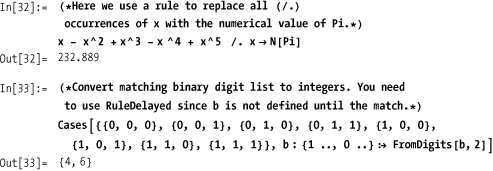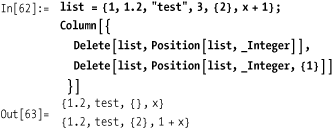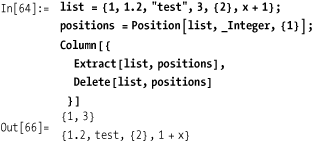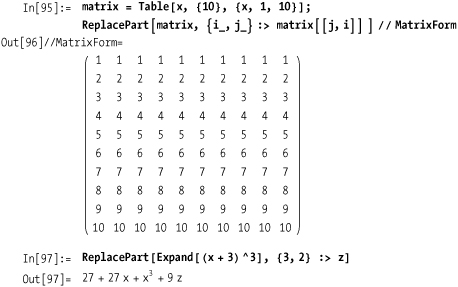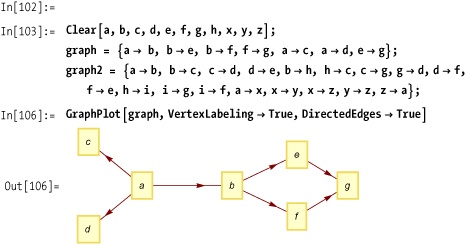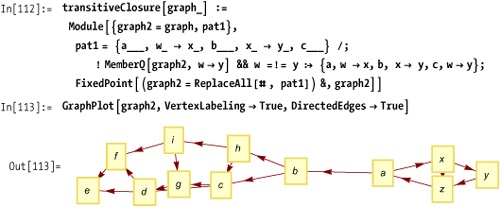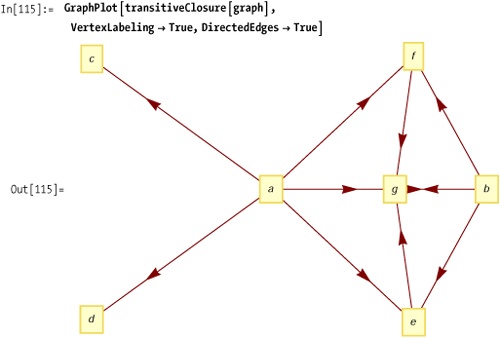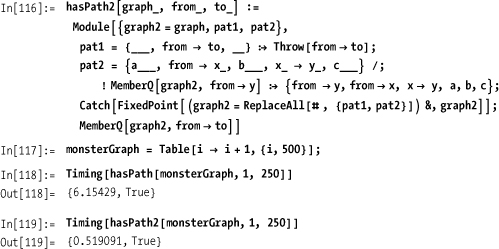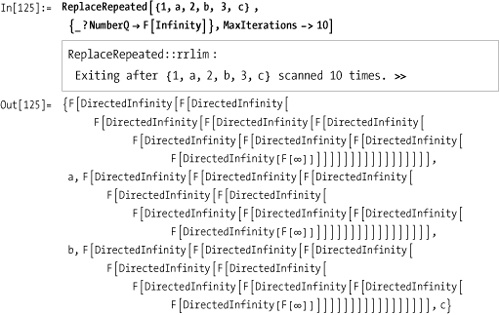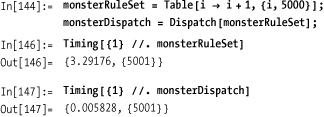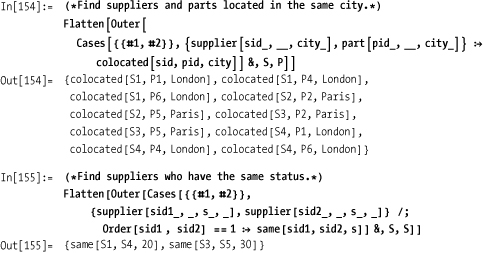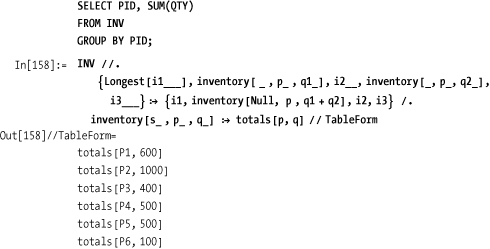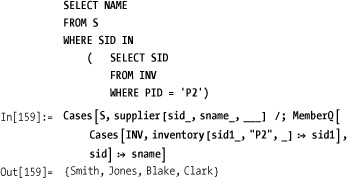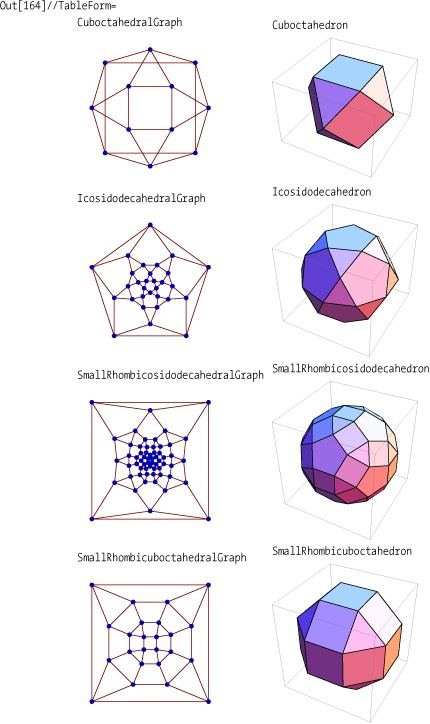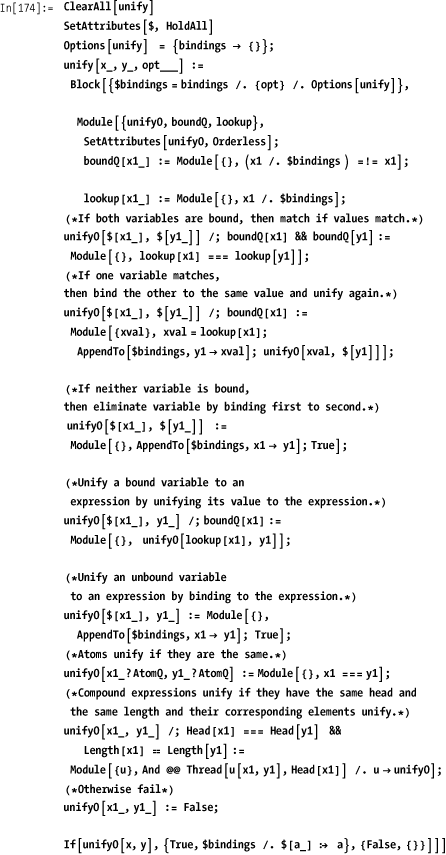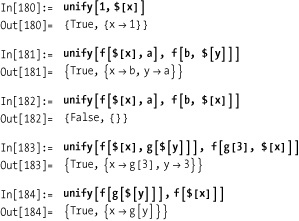Chapter 4. Patterns and Rule-Based Programming
You are an obsession I cannot sleep I am your possession Unopened at your feet There’s no balance No equality Be still I will not accept defeat
I will have you Yes, I will have you I will find a way and I will have you Like a butterfly A wild butterly I will collect you and capture you
—Animation, “Obsession”
4.0 Introduction
In Chapter 2, I argue that the functional style of programming is the preferred way to solve problems in Mathematica. Although functions form much of the brawn, pattern matching provides the brains. In fact, functions and patterns should be thought of as partners rather than competitors. By mastering both functional programming and pattern-based programming, you will be able to use Mathematica to its fullest potential. In fact, once you get the hang of pattern-based solutions they may become a bit of an obsession.
If you have done any programming that involves text manipulation, you have no doubt been exposed to regular expressions, a concise syntax for describing patterns in text and manipulating text. Mathematica’s pattern syntax generalizes regular expressions to the domain of symbolic processing, which allows you to manipulate arbitrary symbolic structures. Patterns and rules are at the foundation of Mathematica’s symbolic processing capabilities. Symbolic integration, differentiation, equation solving, and simplification are all driven by the pattern primitives explained in this chapter.
In the context of Mathematica, a pattern is
an expression that acts as a template against which other expressions
can be matched. Some of the most useful patterns contain variables that
are bound to values as a result of the matching process. However, many
times just knowing that a pattern matched is sufficient. Patterns are
central to specifying constraints in function arguments (e.g., Integer). They also play roles in parsing,
replacing, and counting, as we show in the recipes here. I defer the
role of patterns in string manipulation to Chapter 5.
Rules build on patterns by specifying a mapping from a pattern to
another expression that uses all or parts of the matched results. Rules
pervade Mathematica, as you will see in this chapter’s recipes and
throughout this book. It’s safe to say that Mathematica would be almost
as crippled by the removal of rules as it would be by the removal of the
definition for Plus.
The rest of this introduction gives a brief overview of the most important primitives associated with pattern matching. This will make the recipes a bit easier to follow if you are new to these concepts. The recipes will explore the primitives more deeply, and as usual, you should refer to the Mathematica documentation for subtle details or clarification.
Blanks
The most basic pattern constructs are Blank[] (__), BlankSequence[] (_), and
BlankNullSequence[] (__). Blank[]
matches any expression (_), whereas
Blank[h] (_h) matches any
expression with head h. BlankSequence (__) means one or more;
BlankNullSequence means zero or
more. Thus, ___h means zero or more
expressions with head h. Here
MatchQ tests if a pattern matches
an expression.
In[1]:= MatchQ[a,_] Out[1]= True In[2]:= MatchQ[a[l], _a] Out[2]= True In[3]:= (*By itself a has head Symbol.*) MatchQ[a,_a] Out[3]= False In[4]:= MatchQ[{1, 2}, _List] Out[4]= True
Blanks are more powerful when you can determine what
they are matched against so you can use the matched value for further
processing. This is most often done using a prefix symbol (e.g.,
x_, x__, x___). This syntax should
be familiar since it is most commonly used for function arguments.
However, as shown in this recipe, there are other contexts where
binding symbols to matches comes into play.
In[5]:= (*f1 will match when called with a single integer argument.*) f1[n_Integer] := {n} (*f2 will match when called with one or more integers.*) f2[n__Integer] := {n} (*f3 will match when called with zero or more integers.*) f3[n___Integer] := {n} In[8]:= f1[10] (*Match*) Out[8]= {10} In[9]:= f1[10, 20] (*No match*) Out[9]= f1[10, 20] In[10]:= f2[10, 20] (*Match*) Out[10]= {10, 20} In[11]:= f2[] (*No match*) Out[11]= f2[] In[12]:= f3[] (*Match*) Out[12]= {} In[13]:= f3[1, 2, "3"] (*No match*) Out[13]= f3[1, 2, 3]
Alternatives
Sometimes you need to construct patterns that match two or more
forms. This can be done using Alternatives[p1,p2, ...,pn] or, more
commonly, using vertical bar p1|p2|...|pn.
In[14]:= Cases[{a, r, t, i, c, h, o, k, e}, a|e|i|o|u]
Out[14]= {a, i, o, e}This form can also appear in functions.
In[15]:= Clear[f] f[x_Complex |x_Real|x_Integer] := x
Repeats
You use Repeated[p]
or p.. to match one or more
instances of some pattern p; you
use RepeatedNull[p] or p... to match zero or more instances of
p.
In[18]:= Cases[{{0, 0, 0}, {0, 0, 1}, {0, 1, 0}, {0, 1, 1}, {1, 0, 0}, {1, 0, 1}, {1, 1, 0}, {1, 1, 1}}, {1 .., 0 ..}] Out[18]= {{1, 0, 0}, {1, 1, 0}} In[19]:= Cases[{{0, 0, 0}, {0, 0, 1}, {0, 1, 0}, {0, 1, 1}, {1, 0, 0}, {1, 0, 1}, {1, 1, 0}, {1, 1, 1}}, {1 ..., 0 ...}] Out[19]= {{0, 0, 0}, {1, 0, 0}, {1, 1, 0}, {1, 1, 1}}
PatternSequence
Repeated (p..) matches a very
specific sequence, whereas BlankSequence
(x__) is very general. Sometimes you need to match a
sequence of intermediate specificity. PatternSequence was introduced in
Mathematica 6 to help achieve this. The following means f is a function that takes exactly two
expressions.
In[20]:= Clear [f]; f[x : PatternSequence[_, _]] := Power[x] In[22]:= f[1] (*No match, too few*) Out[22]= f[1] In[23]:= f[2, 3] (*Match*) Out[23]= 8 In[24]:= f[2, 3, 4] (*No match, too many*) Out[24]= f[2, 3, 4]
Above, Pattern Sequence is
not strictly necessary because f[x_,y_] :=
Power[x,y] is the more conventional notation, but consider
these more interesting use cases.
f[0 | PatternSequence[]] := 0 (*Matches either f[0] or f[]*) f[p : PatternSequence[_,_],___] := {p} (*Names the first two elements of a sequence and discards the rest*) f[p : Longest@PatternSequence[a,b]..,rest___] (*The longest repeated sequence of a,b*)
Except
Often, it is easier to describe what you don’t want to
match than what you do. In these cases, you can use Except[p] to indicate matching for
everything except what matches p.
In[25]:= Cases[{a, r, t, i, c, h, o, k, e}, Except[a|e|i|o|u]]
Out[25]= {r, t, c, h, k}Conditions and Pattern Tests
Conditions allow you to qualify a pattern with an additional test that the matching element must pass for the match to succeed. This is a powerful construct because it extends the degree of control over the matching process to any criteria Mathematica can compute.
In[26]:= Cases[{{0, 0, 0}, {0, 0, 1}, {0, 1, 0}, {0, 1, 1}, {1, 0, 0}, {1, 0, 1}, {1, 1, 0}, {1, 1, 1}}, b__/; Total[b] >1] Out[26]= {{0, 1, 1}, {1, 0, 1}, {1, 1, 0}, {1, 1, 1}}
Pattern tests also qualify the match, but they apply to the entire pattern and, therefore, don’t require pattern variables. The following lists all primes less than 250 + 2 of the form 2n± 1.
In[27]:= Cases[Union[Flatten[Table[{2^n - 1, 2^n + 1}, {n, 0, 50}]]], _?PrimeQ] Out[27]= {2, 3, 5, 7, 17, 31, 127, 257, 8191, 65 537, 131071, 524287, 2147483647} In[28]:= Cases[Union[Flatten[Table[{2^n - 1, 2^n + 1}, {n, 0, 50}]]], _?(#1 < 127 &)] Out[28]= {0, 1, 2, 3, 5, 7, 9, 15, 17, 31, 33, 63, 65}
Note
A common mistake is to write the last example in one of two ways that will not work:
In[29]:= Cases[Union[Flatten[Table[{2^n - 1, 2^n + 1}, {n, 0, 50}]]], _?(#1 < 127)&] (*wrong!*) Out[29]= {} In[30]:= Cases[Union[Flatten[Table[{2^n - 1, 2^n + 1}, {n, 0, 50}]]], _?#1 < 127&] (*wrong!*) Out[30]= {}
I still make this mistake from time to time, and it’s frustrating; pay attention to those parentheses!
Rules
Rules take pattern matching to a new level of
expressiveness, allowing you to perform transformations on matched
expressions. Rules are an integral part of Mathematica internal
operations and are used in expressing solutions to equations (see
11.6 Solving Differential Equations), Options (see 2.17 Creating Functions That Accept Options), and SparseArrays (see 3.8 Using Sparse Arrays to Conserve Memory). Rules are also the foundation of
Mathematica’s symbolic abilities. With all these applications, no
serious user of Mathematica can afford to ignore them.
A good way to gain insight into the difference between -¿ and :-i is to consider replacements of a randomly generated number.
See Also
The tutorial of pattern primitives is a useful resource: tutorialiPatternsAndTransformationRules. Committing most of these to memory will strengthen your Mathematica skills considerably.
4.1 Collecting Items That Match (or Don’t Match) a Pattern
Problem
You have a list or other expression and want to find values that match a pattern. You may also want to transform the matching values as they are found.
Solution
Use Cases with a pattern to
produce a list of expressions that match the pattern.
In[36]:= list = {1, 1.2, "test", 3, {2}, x + 1}; Cases[list, _Integer] Out[37]= {1, 3}
Use a rule to transform matches to other forms. Here the matched
integers are squared to produce the result. This added capability of
Cases is extremely powerful.
In[38]:= Cases[list, x_Integer :> x^2]
Out[38]= {1, 9}Wrapping the pattern in Except gives the nonmatching values.
In[39]:= Cases[{1, 1.2, "test", 3, {2}, x + 1}, Except[_Integer]]
Out[39]= {1.2, test, {2}, 1 + x}Note the use of colon syntax when capturing the value matched
using Except with a rule-based
transformation. Here I use a rule that demonstrates that the type of
object produced does not need to be the same as the type that matched
(i.e., all results here are symbols).
Discussion
Cases will work with any
expression, not just lists. However, you need to keep in mind that
Mathematica will rearrange the expression before the pattern is
applied.
In[41]:= Cases[x + y - z^2 + z^3 + x^5, _^_]
Out[41]= {x5, z3}You may have expected z^2 or -z^2 to be selected; examining the FullForm of the expression will reveal why
it was not. FullForm is your friend when it comes to debugging pattern
matching because that is the form that Mathematica sees.
In[42]:= x + y - z^2 + z^3 + x^5 // FullForm
Out[42]//FullForm=
Plus[x, Power[x, 5], y, Times[-1, Power[z, 2]], Power[z, 3]]Providing a level specification will allow you to reach down deeper. Level specifications are discussed in 3.9 Manipulating Deeply Nested Lists Using Functions with Level Specifications.
In[43]:= Cases[x + y - z^2 + z^3 + x^5, _^_, 2]
Out[43]= {x5, z2, z3}You can also limit the number of matches using an optional fourth argument.
In[44]:= Cases [x + y - z^2 + z^3 + x^5, _^_, 2, 1]
Out[44]= {x5}Take into account the attributes Flat and Orderless when pattern matching. Flat means nested expressions like Plus[a,Plus[b,c]] will be flattened;
Orderless means the operation is
communicative, and Mathematica will account for this when pattern
matching.
In[45]:= Attributes[Plus]
Out[45]= {Flat, Listable, NumericFunction, OneIdentity, Orderless, Protected}Here we select every expression that contains b +, no matter its level or order in the
input expression.
In[46]:= Cases[{a + b, a + c, b + a, a^2 + b, Plus[a, Plus[b, c]]}, b + _]
Out[46]= {a + b, a + b, a2 + b, a + b + c}Hold will suppress
transformations due to Flat and
Orderless, but the pattern itself
is still reordered from b + a to
a + b. In 4.8 Preventing Evaluation Until Replace Is Complete we show how to
prevent this using HoldPattern.
In[47]:= Cases[Hold[a + b, a + c, b + a, a^2 + b, Plus[a, Plus[b, c]]], b + a]
Out[47]= {a + b}An alternative to Cases is the combination of Position and Extract. Here Position locates the items, and Extract returns them. This variation would
be more helpful than Cases, for
example, if you needed to know the positions as well as the items,
since Cases does not provide
positional information. By default, Position will search every level, but you
can restrict it with a levelspec as I do here.
In[48]:= list = {1, 1.2, "test", 3, {2}, x +1}; positions = Position[list, _Integer, {1}]; Extract[list, positions] Out[50]= {1, 3}
One useful application of this idiom is matching on one list and extracting from a parallel list.
In[51]:= names = {"Jane", "Jim", "Jeff", "Jessie", "Jezebel"}; ages = {30, 20, 42, 16, 69} ; Extract[names, Position[ages, x_ /; x >30]] Out[53]= {Jeff, Jezebel}
See Also
3.9 Manipulating Deeply Nested Lists Using Functions with Level
Specifications also
discusses Position and Extract in greater detail.
4.2 Excluding Items That Match (or Don’t Match) a Pattern
Problem
You have a list or other expression and want to exclude elements that do not match a pattern.
Solution
DeleteCases has features
similar to Cases but excludes
elements that match.
In[54]:= DeleteCases[{1, 1.2, "test", 3, {2}, x + 1}, _Integer]
Out[54]= {1.2, test,{2}, 1 + x}Wrapping the pattern in Except makes DeleteCases work like Cases for the noninverted pattern.
In[55]:= DeleteCases[{1, 1.2, "test", 3, {2}, x + 1}, Except[_Integer]]
Out[55]= {1, 3}Cases and DeleteCases can be made to return the same
result by using Except, but
Cases should be used when you want
to transform the items that remain (see 4.1 Collecting Items That Match (or Don’t Match) a
Pattern).
In[56]:= DeleteCases[{1, 1.2, "test", 3, {2}, x + 1}, Except[_Integer]] = Cases[{1, 1.2, "test", 3, {2}, x + 1}, _Integer] Out[56]= True
Discussion
Most of the variations supported by Cases discussed in 4.1 Collecting Items That Match (or Don’t Match) a
Pattern apply to
DeleteCases as well. In fact, given
the existence of Except, one could
argue that DeleteCases is
redundant. However, given the context of the problem, usually either
Cases or DeleteCases will be easier to understand
compared to using pattern inversions. Also, Except has some limitations since pattern
variables like x_ can’t appear
inside of an Except.
Use levelspecs to constrain deletions to particular portions of an expression tree. Here is an expression that is nine levels deep.
You can delete roots at level four.
You can also delete roots at levels up to four.
Or, you delete roots at every level.
Just as Extract plus Position is the equivalent of Cases (discussed in 4.1 Collecting Items That Match (or Don’t Match) a
Pattern), Delete plus Position is the equivalent for DeleteCases. Again, remember that Position looks at all levels unless you
restrict it.
This leads to a way to get the results of Cases and DeleteCases without executing the pattern
match twice.
4.3 Counting Items That Match a Pattern
Problem
You need to know the number of expressions that match a pattern by matching the expressions themselves or their position.
Solution
Use Count to count matching
elements in an expression or at particular levels in an expression.
Counting literal matches is perhaps the simplest application of
Count.
In[67]:= Count[{a, 1, a, 2, a, 3}, a]
Out[67]= 3By default, Count works only
on level one (levelspec {1}), but you can provide alternate levelspecs
as a third argument.
In[68]:= expr = 1 + 3 I + 4 + I x + x ^ 2 + yxx; { Count[expr, x], Count[expr, x, Infinity]} Out[69]= {0, 4}
Count can be derived
from Position or Cases, so these are handy if you need the
matching items (or positions) in addition to the count.
In[70]:= Length[Cases[{a, 1, a, 2, a, 3}, a]] Out[70]= 3 In[71]:= Length[Position[{a, 1, a, 2, a, 3}, a, {1}]] Out[71]= 3
Discussion
Other counting functions include LeafCount and Tally. It is difficult to emulate LeafCount using Count because LeafCount treats complex numbers in their
FullForm (e.g., Complex[1,1] has LeafCount == 3) but using FullForm on an expression does not provide
the right answer.
You need to eliminate the complex numbers using ReplaceAll before performing the count, so
LeafCount is rather unique.
Tally counts equivalent
elements in a list using SameQ or a
user-supplied equality test. It works only on lists, so you’ll need to
convert expressions with other heads to List before using Tally. The output is a list of pairs showing
the element and its count.
In[74]:= Tally[{a, x, a, x, a, a, b, y}] Out[74]= {{a, 4}, {x , 2}, {b, 1}, {y, 1}} In[75]:= Tally[Flatten@Apply[List, expr, {0, Infinity}]] Out[75]= {{5 + 3 i, 1}, {i, 1}, {x , 4}, {2, 1}, {y, 1}}
Here is an example using a different equivalence relation (congruence module 7).
In[76]:= Tally[Prime[Range[100]], Mod[#1, 7] == Mod[#2, 7] &]
Out[76]= {{2, 18}, {3, 18}, {5, 18}, {7, 1}, {11, 14}, {13, 16}, {29, 15}}See Also
Level specifications are covered in detail in 3.9 Manipulating Deeply Nested Lists Using Functions with Level Specifications.
4.4 Replacing Parts of an Expression
Solution
Use ReplacePart, which can
use indices or index patterns to limit the scope of a
replacement.
Place an x at prime-numbered positions. Note that the position is being tested for primality, not for value.
In[79]:= ReplacePart[{a, b, c, d, e, f, g, h, i}, {i_?PrimeQ :> x}]
Out[79]= {a, x, x, d, x, f, x, h, i}If you want access to the value as well, you can use the position to index into the list.
Discussion
On first encounter, you might think ReplacePart and part assignment are
redundant.
In[81]:= list1 = {1, 2, 3, 4, 5, 6}; list1[[{1, 3}]] = 99; list1 Out[83}= {99, 2, 99, 4, 5, 6}
This seems similar to what is achieved using ReplacePart.
However, there are a multitude of differences. First, ReplacePart does not modify the list but
creates a new list with modified values.
In[86]:= {list1, list2}
Out[86]= {{1, 2, 3, 4, 5, 6}, {99, 2, 99, 4, 5, 6}}A related difference is that assignment is meaningful only to
symbols, not expressions. In contrast, ReplacePart can use either as input.
Another important difference is that it is harmless to specify
an index that does not match. ReplacePart simply returns a new list with
the same content. Contrast this to part assignment, where you get an
error.
Part assignment gains flexibility by supporting ranges and lists
of position, whereas ReplacePart
uses index patterns.
ReplacePart works on
arbitrarily nested expressions, including matrices. Also note that the
index patterns can be referenced on the right side of rules.
The following use case performs a transpose.
See Also
Chapter 3 covers list manipulation in
detail, including the use of Part.
4.5 Finding the Longest (or Shortest) Match for a Pattern
Problem
A replacement rule is not working the way you think it should.
In particular, it seems to work on only part of the expression. Often
this is an indication that you need greedy matching provided by
Longest.
Solution
By default, sequence patterns like a__ and a___ act as if they are surrounded by
Shortest. This means they match as
little as possible to still be consistent with the entire pattern. The
following repeated replacement seems like it should shuffle items in
the list until all equal values are adjacent. It almost works, but a 3
and a 1 stubbornly remain in place. This happens because on the final
pass a__ matches nothing (which is
shortest), b_ matches 1, c__ matches 1, b_ matches the third 1, and d___ matches the remainder. This results in
a null transformation, so Replace-Repeated stops.
In[98]:= {1, 3, 1, 4, 1, 3, 4, 2, 7, 1, 8} //. {{a___, b_, c__, b_, d___} -> {b , b, a, c, d}} Out[98]= {1, 1, 1, 3, 4, 3, 4, 2, 7, 1, 8}
Contrast this to the same transformation using Longest. Here we force a___ to greedily gobble up as many elements
as it can and still keep the rest of the pattern matching.
In[99]:= {1, 3, 1, 4, 1, 3, 4, 2, 7, 1, 8} //. {{Longest[a___], b_, c__, b_, d___} -> {b , b, a, c, d}} Out[99]= {1, 1, 1, 1, 3, 3, 4, 4, 2, 7, 8}
Forcing a___ to match as much
as it can and yet still satisfy the rest of the pattern results in all
sequences of identical elements separated by one or more other
elements (b_, c__ ,b_) to be
found.
Discussion
Readers familiar with regular expression will recognize the
solution example as illustrating the difference between greedy and
nongreedy matching. This difference is the source of infinite
frustration to pattern writers because, depending on your test case,
nongreedy patterns can appear to work most of the time. Always
consider what will happen if patterns like a__ match only one item and a__ matches nothing. Often this is what you
want, but almost as often it is not!
A reasonable question to ask is why there is a Shortest if it is the default. For string
patterns (see Chapter 5), the
default is reversed. You may also use Shortest to document that it is your intent,
but you should probably limit this to portions of the pattern that are
up front.
Also keep in mind that if multiple Shortest or Longest directives are used, the ones that
appear earlier are given higher priority to match the shortest or
longest number of elements, respectively.
See Also
Mastering Regular Expressions by
Jeffrey E. F. Friedl (O’Reilly) has an extensive discussion of greedy
versus lazy matching that is relevant to understanding Longest and Shortest. This book is a good investment if
you also make use of Mathematica’s regular expression syntax for
string manipulation.
4.6 Implementing Algorithms in Terms of Rules
Problem
You need to implement an algorithm that can be viewed as a transformation from a start state to a goal state.
Solution
Many problems are elegantly stated in a few simple transformation rules. Here I show some simple examples; the discussion will try a few more ambitious tasks.
Imagine you have a graph of vertex-to-vertex connection rules.
This is the notation used by GraphPlot and the functions in the GraphUtilities' package.
The idea in this solution is to find a path from the
from node to some intermediate node
x, and from x to some node y, and then add the path from→y if it does not already exist.
Continue this until the graph no longer changes (hence FixedPoint). Then check if from→to is present using MemberQ.
You can test hasPath on the
graph in Out[106] on See Also.
In[109]:= hasPath[graph, a, g] Out[109]= True In[110]:= hasPath[graph, b, d] Out[110]= False
Here is an exhaustive test of the vertex c in the graph in Out[113].
Here is a related function to compute the transitive closure of a graph.
Here you compute the transitive closure of Out[113].
Out[115] is the plot of the transitive closure of the simpler graph from Out[106] on See Also.
Discussion
The hasPath and transitiveClosure functions share a common
property. They are implemented by repeated transformation of the input
until some goal state is achieved. The search terminates when there
are no more available transformations, as determined by FixedPoint. TransitiveClosure uses the final state as
the result, whereas hasPath makes
one more match using MemberQ to see
if the goal was reached.
Although rule-driven algorithms tend to be small, they are not
always the most efficient. HasPath
finds all paths from the start node before making a
determination.
The hasPath2
implementation here uses Catch-Throw to exit as soon as the solution
is found.
The main components of this solution are:
Localization:
Module[ {rules, start, next, final}, .. ]Rules: Enumeration of the rules with tests against
next(graph2plays the role ofnextin the examples). An optionalThrow ruledetects success for early termination.Repetition:
next = ReplaceAll[next, rules]Stopping criteria:
final = FixedPoint[ .. , start]. Assignment tofinalallows the result to undergo some post processing. In the examples,finalwas implicit. If aThrow ruleis used,FixedPointshould be wrapped in aCatch.Postprocessing: Extract results from
final. HereMemberQis used to test if the path was found.
If you have trouble following one of these solutions,
Mathematica will show its work if you use FixedPointList. For example, here is the
expansion of the steps in hasPath.
This shows each step in the transition from the original graph to the one with all intermediate steps filled in. Try to work out how the rule took each line to the next line. Only by working through examples like this will you begin to master the concepts.
See Also
FixedPoint usually finds
application in numerical methods that use iteration, such as Newton’s
method (see 2.12 Building a Function Through Iteration),
but any algorithm that computes until an equilibrium state is reached
can use FixedPoint.
4.7 Debugging Infinite Loops When Using ReplaceRepeated
Problem
Mathematica went into an infinite loop when you used //. (ReplaceRepeated), and the reason is not
immediately obvious.
Solution
ReplaceRepeated is often very
handy but also dangerous because it only terminates when the result
stops changing. The simplest thing to do is to test ReplaceRepeated with the option MaxIterations set to a reasonably small
value (the default is 65,536).
It should be clear that this will never terminate. Any
transformation that adds structure is doomed. However, sometimes the
end result obtained when clamping iterations does not immediately
reveal the problem. In such cases, it helps to see the whole sequence
of transformations. You can do that using NestList and ReplaceAll to emulate a ReplaceRepeated with a small number of
iterations that return the result after each iteration.
Here the problem is an oscillating transformation that will never settle down. You could probably see that by inspection, but seeing each step makes it obvious.
Discussion
Sometimes applying the debugging techniques in the solution can
still leave you stumped. Here is an example that one would expect to
terminate based on the fact that NumberQ[Infinity] is false.
In situations like this, you should try applying
FullForm to the output to see what
Mathematica sees rather than what it shows you.
In[126]:= FullForm[%]
Out[126]//FullForm=
List[F[DirectedInfinity[
F[DirectedInfinity[F[DirectedInfinity[F[DirectedInfinity[
F[DirectedInfinity[F[DirectedInfinity[F[DirectedInfinity[F[
DirectedInfinity[F[DirectedInfinity[
F[DirectedInfinity[1]]]]]]]]]]]]]]]]]]]],
a, F[DirectedInfinity[F[DirectedInfinity[F[DirectedInfinity[
F[DirectedInfinity[F[DirectedInfinity[F[DirectedInfinity[
F[DirectedInfinity[F[DirectedInfinity[F[DirectedInfinity[
F[DirectedInfinity[1]]]]]]]]]]]]]]]]]]]],
b, F[DirectedInfinity[F[DirectedInfinity[F[DirectedInfinity[
F[DirectedInfinity[F[DirectedInfinity[F[DirectedInfinity[
F[DirectedInfinity[F[DirectedInfinity[F[DirectedInfinity[
F[DirectedInfinity[1]]]]]]]]]]]]]]]]]]]], c]Do you see the problem? It is near the end of the output. If you can’t see it, consider this.
In[127]:= FullForm[Infinity]
Out[127]//FullForm=
DirectedInfinity[1]The full form of Infinity contains the integer 1, which is being
matched and replaced with F[DirectedInfinity[l]] and so on, ad
infinitum. In this simple case, ReplaceRepeated was not needed because
ReplaceAll would do the trick. If
ReplaceRepeated is necessary, break
the process into two steps, first using a proxy for the construct that
has the hidden representation that is messing you up. Here I use Inf
instead of Infinity.
See Also
You can find a realistic example of the Infinity problem at the Wolfram MathGroup
Archives: http://bit.ly/2oRAuZ.
4.8 Preventing Evaluation Until Replace Is Complete
Problem
You are trying to transform an expression, but the structure you want to transform is disappearing due to evaluation before you can transform it.
Solution
Use Hold and ReleaseHold with the replacement.
This does not work the way you probably intended.
This preserves the structure until the transformation is complete, then allows it to evaluate.
A related problem is wanting the left side of a replacement rule
to remain unevaluated. In this case, you need to use HoldPattern.
This is equivalent to ReleaseHold[Hold[1 + 1 + 1 + 1 + 1] /. 4 :> 2 + 2 +
2 + 2].
In[131]:= ReleaseHold[Hold[1 + 1 + 1 + 1 + 1] /. 1 + 1 + 1 + 1 :> 2 + 2 + 2 + 2 ] Out[131]= 5 In[132]:= (*This works as intended by preserving the structure of the pattern.*) ReleaseHold[ Hold[1 + 1 + 1 + 1 + 1 ] /. HoldPattern[1 + 1 + 1 + 1] : > 2 + 2 + 2 +2] Out[132]= 9
Discussion
Keep in mind that HoldPattern[expr] differs from Hold[expr]. From a pattern-matching point of
view, HoldPattern[expr] is
equivalent to expr alone except it prevents evaluation. Hold[expr] includes the Hold as part of the pattern.
In[133]:= GO = "gone"; In[134]:= Hold[1 + 2 + 3] /. HoldPattern[1 + 2 + 3] :> GO Out[134]= Hold[GO] In[135]:= Hold[1 + 2 + 3] /. Hold[1 + 2 + 3] :> GO Out[135]= gone
See Also
Chapter 2 discusses
Hold in more detail.
4.9 Manipulating Patterns with Patterns
Problem
You need to transform a pattern expression using patterns.
Solution
Use Verbatim to allow a
pattern to match another pattern. Here Verbatim tells Mathematica to treat the
expression literally.
Here we want to split up a pattern variable into the name and the head it matches.
Discussion
The key to understanding the solution is to consider the
FullForm of pattern
variables.
In[138]:= {FullForm[x_], FullForm[x__], FullForm[x___], FullForm[x_Integer]}
Out[138]= {Pattern[x, Blank[]], Pattern[x, BlankSequence[]],
Pattern[x, BlankNullSequence[]], Pattern[x, Blank[Integer]]}Without Verbatim, the first
example in the first part of the solution would go wrong.
The second part of the solution would fail because a pattern can’t have another pattern as its name.
Verbatim[expr] says “match
expr
exactly as it appears.” You will not use Verbatim often unless you find yourself
writing Mathematica code to transform Mathematica code, as you might
if you were writing a special interpreter or code to rewrite
Mathematica code containing patterns in some other form.
See Also
The Mathematica Programmer II by Roman
Maeder (Academic Press) uses Verbatim during the development of an
interpreter for a Prolog-like language.
4.10 Optimizing Rules
Problem
You have a large list of frequently used rules and want to speed up processing.
Discussion
If you do a lot of multiple-rule transformations, it is convenient to store all the rules in a single variable. This common practice makes maintenance of your code simpler since there is only a single definition to maintain for all rules. However, the penalty for doing this is that the performance of a replace decreases as the number of rules increases. This is because each rule must be scanned in turn, even if it ends up being inapplicable to a given transformation. Rule dispatch tables optimize rule dispatch so it is mostly independent of the number of rules.
To test this claim, I generate a list of 5,000 rules, called
monsterRuleSet, and then optimize
it to create monsterDispatch. The
timing on the monsterRuleSet is
very poor, whereas the dispatched version is lickety-split.
Peering into the implementation, you can see that the secret to
Dispatch’s success is a hash
table.
In[148]:= monsterDispatch[[2]] // Short
Out[148]//Short=
{HashTable[1, 5000, 1, {{10, 2856}, {}, {3110, 3440}, {}, {1245}, <<4989>>,
{3060}, {1008}, {912}, {879, 3696, 4165, 4971}, {545, 676, 4204}}]}4.11 Using Patterns As a Query Language
Problem
You want to perform SQL-like queries on data stored in Mathematica.
Solution
Consider data of the sort one might encounter in a relational database but encoded in Mathematica form. This example is taken from the classic introduction to databases by C. J. Date.
In[149]:= S = {
supplier["S1" , "Smith", 20, "London"],
supplier["S2", "Jones" , 10 , "Paris"],
supplier["S3", "Blake" , 30 , "Paris"],
supplier["S4", "Clark" , 20 , "London"],
supplier["S5", "Adams" , 30 , "Athens"]
};
P = {
part["P1", "Nut" , "Red", 12, "London"] ,
part["P2" , "Bolt" , "Green", 17, "Paris"],
part["P3" , "Screw", "Blue", 17, "Rome"],
part["P4" , "Screw", "Red", 14, "London"],
part["P5" , "Cam", "Blue", 12, "Paris"],
part["P6" , "Cog", "Red" , 19, "London"]
};
INV = {
inventory["S1" , "P1" , 300],
inventory["S1" , "P2" , 200],
inventory["S1" , "P3" , 400],
inventory["S1" , "P4" , 200],
inventory["S1" , "P5" , 100],
inventory["S1" , "P6" , 100],
inventory["S2" , "P1" , 300],
inventory["S2" , "P2" , 400],
inventory["S3" , "P2" , 200],
inventory["S4" , "P2" , 200],
inventory["S4" , "P4" , 300],
inventory["S4" , "P5" , 400]
};Simple queries can be done using Cases alone.
In[152]:= (*Find suppliers in Paris.*) Cases[S, supplier[_, _, _, "Paris"] ] Out[152]= {supplier[S2, Jones, 10, Paris], supplier[S3, Blake, 30, Paris]} In[153]:= (*Find suppliers in Paris with status greater than 10.*) Cases[S, supplier[_, _, status_/; status > 10, "Paris"]] Out[153]= {supplier[S3, Blake, 30, Paris]}
Queries involving joins can be implemented with the help
of Outer.
Discussion
If the data you need to query resides in a database, it makes more sense to let that database do the query work before the data is imported into Mathematica. If this is not the case, Mathematica can easily do the job, even for rather sophisticated queries. Here are some simple examples with SQL equivalents.
Find all pairs of cities where a supplier in the first city has inventory on a part in the second city.
In this case, ReplaceRepeated can be used to implement
GROUP BY. The idea is to
continually search for pairs of items that match on the grouping
criteria and combine them according to some aggregation method, in
this case the sum of qty. Since
each replacement removes an inventory item, we are guaranteed to
terminate when all items are unique. A final ReplaceAll is used to extract the relevant
information. The use of Null in the replacement rule is just for
aesthetics, conveying that when you aggregate two inventory records
you no longer have a valid record for a particular supplier.
Suppose you want the names of suppliers who have inventory in
the part P1. This involves
integrating information from S and INV. This can be done as a join, but in SQL
it can also be done via a subquery. You can emulate that using rules.
Here MemberQ implements the
semantics of the SQL IN.
In the examples given, I have demonstrated queries for which the data is in relational form. One feature of relational form is that it is normalized so that each column can hold only atomic data. However, Mathematica is not a relational database, so data can appear in just about any form with any level of nesting. This is no problem because patterns are much more flexible than SQL. Still, I find it easier to put data in a tabular form before trying to extract information and relationships with other collections of data. Let’s consider an example that is more in the Mathematica domain.
GraphData and PolyhedronData are two extensive data
sources that are bundled with Mathematica 6 and later versions. The
relationship between these data sources is that each polyhedron has an
associated graph. In PolyhedronData, the property that ties the
two sources together is called SkeletonGraph. In database jargon, SkeletonGraph is a foreign
key to GraphData, and thus, allows us to investigate
relationships between polyhedra and their associated graphs. For this
example, I want to consider all graphs that are both Eulerian and
Hamiltonian with their associated polyhedron being Archimedean. (An
Archimedean solid is a highly symmetric, semiregular, convex
polyhedron composed of two or more types of regular polygons meeting
in identical vertices.)
It’s often a good idea to see how many results you received.
There are exactly 4 cases out of 13 Archimedean polyhedra that meet the criteria of having both Eulerian and Hamiltonian graphs.
You might find more intuitive ways to solve this
problem, but the solution given emphasizes pattern matching. You could
also use Intersection with an appropriate SameTest, as shown here. The r @@@ serves only to put the result in the
same form as we used previously and is not strictly needed.
In[165]:= results = r @@@ Intersection[Archimedean, Graphs, SameTest ->(#1[[3]] == #2[[1]] &)];
See Also
The supplier-parts database is a classic example borrowed from An Introduction to Database Systems: Volume 1, Fourth Edition, by C.J. Date (Addison-Wesley).
4.12 Semantic Pattern Matching
Problem
You want to work with patterns that reach beyond syntactic (structural) relationships to consider semantic relationships.
Solution
This solution is a simplified adaptation of concepts from “Sernantica: Semantic Pattern Matching in Mathematica” by Jason Harris, published in the Mathematica Journal, Volume 7, Issue 3, 1999.
Pattern matching in Mathematica is strictly structural. Consider
the following function f.
In[166]:= Clear[f] SetAttributes[f, HoldFirst]; f[x_Integer^2] := 1
Clearly, 3^2 matches the
first version of the function. However, neither f[9] nor f[10] are in the correct form, so they fail
to match, even though in the second case 9 ==
3^2.
In[169]:= {f[3^2], f[9], f[10]}]
Out[169]= {1,f[9], f[10]}All hope is not lost. By exploiting patterns, you can
create a semantic match that uses Condition, which is commonly abbreviated as
/;.
In[170]:= Clear[f]; SetAttributes[f, HoldFirst]; f[x_ /; IntegerQ[x] && (Reduce[z^2 == x,{z}, Integers] =!= False)] := 1
Now both the first and second cases match but not the last.
In[173]:= {f[3^2], f[9], f[10]}
Out[173]= {1, 1, f[10]}Discussion
Mathematica deals with structural patterns simply because, in general, it is impossible to determine if two expressions are semantically equivalent. In the 1930s, Gödel, Turing, Church, and others performed the theoretical work that underlies this unfortunate truth. Still, there are many restricted cases for which semantic matching can succeed, as demonstrated in the solution.
4.13 Unification Pattern Matching
Problem
You want to emulate unification-based matching, à la Prolog.
Solution
Unification is more powerful than Mathematica pattern matching
in that it allows pattern variables on both sides of the match. We
can’t use normal pattern variables for this purpose, so we use the
syntax $[var] to denote unification
variable.
Test unify on various
expressions:
Here you pass in a preexisting binding so the unification fails.
See Also
Maeder’s Mathematica Programmer II goes much further than this recipe by implementing a large subset of Prolog. It also allows you to use normal pattern syntax by rewriting the variables using techniques discussed in 3.10 Implementing Bit Vectors and Using Format to Customize Their Presentation.
Get Mathematica Cookbook now with the O’Reilly learning platform.
O’Reilly members experience books, live events, courses curated by job role, and more from O’Reilly and nearly 200 top publishers.

